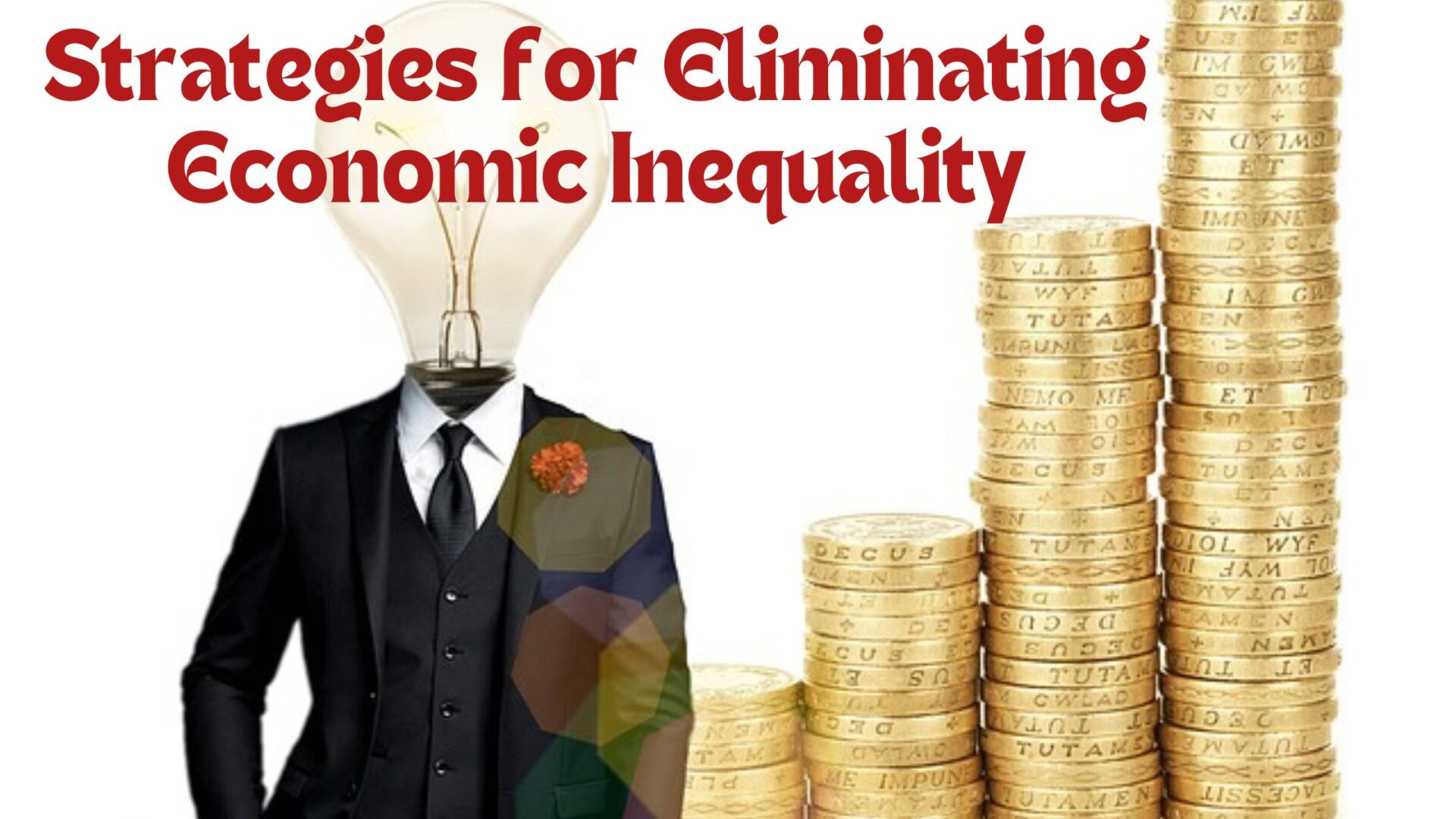Introduction:
Strategies for Eliminating Economic Inequality: A Comprehensive Guide

In today’s rapidly changing world, addressing economic inequality is a crucial endeavor for fostering a fair and just society. This article delves into comprehensive strategies aimed at eliminating economic disparities, providing a roadmap for positive change.
Strategies for Eliminating Economic Inequality
- Understanding the Landscape: To effectively combat economic inequality, it’s vital to first understand its root causes and manifestations. This section explores the various factors contributing to inequality, setting the stage for targeted intervention.
- Empowering Education and Skill Development: Education is a powerful equalizer. Discover how investing in accessible and quality education, coupled with skill development programs, can empower individuals to break the cycle of poverty and contribute meaningfully to the economy.
- Promoting Inclusive Economic Policies: Explore the impact of inclusive economic policies on reducing inequality. From progressive taxation to social welfare programs, learn about policy measures that aim to create a more level playing field for all citizens.
- Encouraging Entrepreneurship and Innovation: Entrepreneurship can be a catalyst for economic empowerment. Uncover how fostering a culture of innovation and supporting small businesses can lead to job creation and income distribution, addressing inequality at its core.
- Ensuring Equal Employment Opportunities: This section examines the importance of promoting diversity and inclusivity in the workplace. By dismantling barriers to entry and advancement, we can create an environment where everyone has a fair chance to succeed.
- Advocating for Fair Wages: Fair compensation is integral to reducing economic inequality. Explore the role of minimum wage policies, income transparency, and fair labor practices in creating a more equitable distribution of wealth.
- Addressing Gender and Racial Disparities: Delve into the specific challenges faced by marginalized groups. Discover strategies to address gender and racial disparities, ensuring that opportunities and resources are accessible to all, regardless of background.
- Building Sustainable Communities: Sustainable development goes hand in hand with reducing economic inequality. Learn how environmentally conscious practices and community development initiatives contribute to long-term economic stability and equality.
- Fostering Financial Literacy: Financial education empowers individuals to make informed decisions about their finances. Explore the impact of promoting financial literacy in mitigating economic inequality and creating a financially savvy population.
- Measuring Progress and Adjusting Strategies: Finally, we explore the importance of continuous evaluation and adaptation. By implementing measurable goals and regularly assessing the effectiveness of strategies, societies can fine-tune their approach to achieving lasting economic equality.
How can we solve economic inequality in India?
Addressing economic inequality in India is a complex task that requires a multi-faceted approach involving government policies, social initiatives, and private sector involvement. Here are several strategies that can contribute to solving economic inequality in India:

- Education Reforms: Invest in education to ensure accessibility and quality at all levels. This includes promoting skill development programs that align with market needs, reducing dropout rates, and bridging the urban-rural education divide.
- Job Creation and Entrepreneurship: Encourage the growth of small and medium-sized enterprises (SMEs) by providing financial support, streamlining regulatory processes, and fostering a culture of innovation. This can lead to increased job opportunities and more inclusive economic growth.
- Progressive Taxation Policies: Implement progressive tax policies to ensure that the burden falls more heavily on those with higher incomes. This can be achieved through a combination of income taxes, wealth taxes, and closing loopholes that benefit the wealthy.
- Social Welfare Programs: Strengthen and expand social welfare programs to provide a safety net for the vulnerable population. Targeted initiatives such as direct cash transfers, food security programs, and healthcare support can help alleviate poverty and reduce economic disparities.
- Land Reforms: Address land ownership patterns to reduce disparities. Land reforms aimed at providing land to landless farmers, ensuring secure land tenure, and preventing land concentration can contribute to more equitable distribution of resources.
- Gender Equality Initiatives: Promote gender equality by addressing wage gaps, providing equal opportunities for education and employment, and implementing policies that empower women economically. Gender-inclusive initiatives can contribute significantly to reducing overall economic inequality.
- Infrastructure Development: Invest in infrastructure development, particularly in rural areas, to bridge the urban-rural divide. Improved connectivity, access to markets, and basic amenities can stimulate economic activities in rural regions, promoting more inclusive growth.
- Financial Inclusion: Expand financial inclusion initiatives to ensure that all segments of the population have access to banking and financial services. This can empower individuals to save, invest, and participate more actively in the formal economy.
- Corruption Control: Implement transparent and accountable governance to curb corruption. A corruption-free environment can ensure that resources are allocated more efficiently and that benefits reach the intended recipients.
- Community Development Programs: Foster community-led development programs that empower local communities to identify and address their specific needs. This bottom-up approach can lead to more sustainable and inclusive development.
- Investment in Healthcare: Strengthen the healthcare system to ensure that everyone has access to quality healthcare. A healthy population is more productive, and addressing health disparities is crucial for reducing economic inequality.
- Social Awareness and Advocacy: Promote awareness and advocacy campaigns to highlight the importance of reducing economic inequality. Engaging the public in discussions about the impact of inequality can lead to greater support for policy changes and social initiatives.
Solving economic inequality in India requires a coordinated effort involving government, civil society, and the private sector. Sustainable and inclusive development policies, coupled with a commitment to social justice, can contribute to creating a more equitable society.
How can we remove inequality from our society?
Removing inequality from society is a complex and long-term challenge that requires a combination of systemic changes, policy interventions, and shifts in societal attitudes. Here are several strategies that can contribute to reducing and ultimately eliminating inequality:

- Education for All: Ensure equal access to quality education at all levels. This includes addressing disparities in educational resources, providing scholarships, and implementing programs to support marginalized communities.
- Equal Employment Opportunities: Enforce and promote non-discriminatory hiring practices. Companies and organizations should foster diversity and inclusion, ensuring that people from all backgrounds have equal opportunities for employment and career advancement.
- Living Wage Policies: Advocate for and implement living wage policies to ensure that all workers earn enough to cover their basic needs. This includes addressing wage gaps and improving the conditions of low-income workers.
- Affordable Healthcare: Ensure access to affordable and quality healthcare for all. A healthy population is a productive one, and addressing healthcare disparities is crucial for reducing overall inequality.
- Social Safety Nets: Strengthen social safety nets and welfare programs to provide a financial safety net for those facing economic hardships. This includes unemployment benefits, food assistance, and housing support.
- Progressive Taxation: Implement progressive taxation policies that place a greater burden on those with higher incomes. This can help redistribute wealth and contribute to a more equitable distribution of resources.
- Land Reforms: Address land ownership patterns to prevent concentration of land in the hands of a few. Land reforms that ensure secure land tenure for marginalized communities can contribute to reducing wealth inequality.
- Gender Equality: Promote gender equality in all aspects of life, including education, employment, and representation. Policies and initiatives that address gender-based discrimination and violence can contribute to a more equitable society.
- Inclusive Economic Policies: Design and implement economic policies that prioritize inclusive growth. This includes investing in sectors that have the potential to create jobs and improve living standards for all segments of the population.
- Community Development Programs: Support community-led development initiatives that empower local communities to address their specific needs. This bottom-up approach can lead to more sustainable and inclusive development.
- Criminal Justice Reform: Address systemic issues in the criminal justice system to ensure fair treatment and opportunities for rehabilitation. This includes addressing biases in policing, sentencing, and promoting alternatives to incarceration.
- Access to Technology: Bridge the digital divide by ensuring that everyone has access to technology and the internet. This is crucial for equal access to information, education, and economic opportunities in the modern world.
- Public Awareness and Advocacy: Raise awareness about the impact of inequality and advocate for policy changes. Engage the public in discussions about social justice and equality to build support for systemic reforms.
- Civic Engagement and Participation: Encourage civic engagement and participation in decision-making processes. Empowering individuals to actively contribute to shaping policies and holding institutions accountable can lead to positive societal change.
- Long-term Cultural Shifts: Work towards changing societal attitudes and cultural norms that perpetuate inequality. Promote values of empathy, tolerance, and inclusivity to create a more equitable and compassionate society.
It’s important to note that addressing inequality requires a comprehensive and sustained effort from individuals, communities, governments, and institutions. Collaboration and a commitment to social justice are essential for creating lasting positive change.
Conclusion:
In conclusion, the journey towards eliminating economic inequality requires a multifaceted and committed approach. By implementing the strategies outlined in this comprehensive guide, societies can take significant strides towards creating a more equitable and inclusive future for all.
